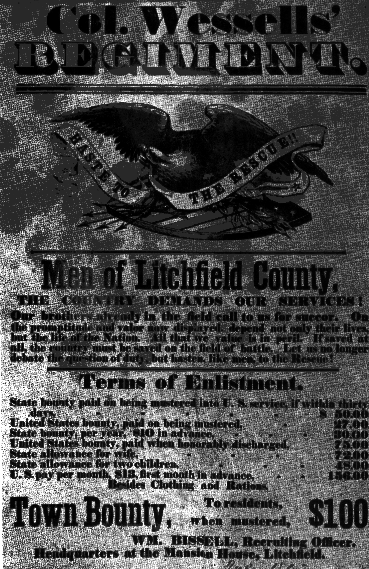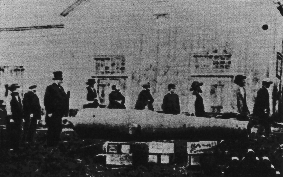

(for brevity I will just quote information pertaining the specific details of Connecticut and her men that fought in the Civil War)
"Friends of Samuel B. Horne of Winsted have claimed that he was the first man in Connecticut to enlist. Horne was only seventeen, but he would not be refused. He enlisted in Company B of the Second Regiment Conn. Volunteers and after three months' enlistment in this Regiment had expired, he enlisted in the Eleventh Conn. Volunteers, and fought in twenty-five battles, was wounded three times, and won the Medal of Honor at the battle of Fort Harrison, Virginia.
"Besides a scattering of men in the two other three months Regiments, two companies of the Second Regiment Conn. Volunteers were entirely composed of Litchfield County men.
"....'The Connecticut Brigade was the last to leave the field at Bull Run, and by hard fighting had to defend itself, and to protect our scattered thousands for several miles of the retreat.'
"After the disaster at Bull Run there quickly sprang up, in and around Litchfield County, a large number of rebel sympathizers. Speakers, imported from other states to address these 'peace meetings,' usually commenced their talk by stating that the war was uncalled for by the North; that the President and his followers were a lot of Abolition Fanatics, and that they would never whip the South, who had a right to secede. Also, that the young men who were enlisting from the North in response to President Lincoln's second call for three years' volunteers were making a mistake.
"At this time this so-called 'Peace Faction' was causing such a great disturbance the Governor Bunckingham on September 1, 1861, issued the following Proclamation:
" "At this critical juncture our liberties are still further imperiled by the utterance of seditious language; by a traitorous press, which excuses or justifies the Rebellion; by secret organizations which propose to resist the execution by force; by the public exhibition of 'Peace Flage,' falsely so-called; and by an effort to redress grievances, regardless of the forms and the officers of the land.'
"The County was most fully represented in the Mountain County Regiment, the Second Conn. Heavy Artillery recruited completely from volunteers from the County towns. This Regiment manned the forts defending Washington, until assigned as Infantry they were sent against the entrenched Confederates at Cold Harbor. They later fought with Gen. Sheridan in the Shenandoah Valley before Petersburg.
"County volunteers, however, participated in all the campaigns of the war; many of the Fifth and Twentieth Conn. Regiments marched with Sherman to Atlanta, and from Atlanta to the Sea. Company I of the First Regiment Conn. Heavy Artillery was composed entirely of Litchfield County men and established a wonderful record in the Peninsular Campaign, winning the special commendation of Gen. McClellan.
"Some Litchfield County men were enlisted in the Fourteenth Conn. Regiment which had been mustered in only two weeks when they were thrown into the war's bloodiest battle at Antietam. In the frightful struggle to capture the bridge over Antietam Creek this Regiment suffered terrific losses. At the battle of Gettysburg the Fourteenth made a brilliant charge, capturing five battle flags and forty prisoners.
"There were volunteers from Canaan and Goshen in the Seventh Conn. Regiment in the campaigns in t he Carolinas and at Fort Pulaski, Georgia. This Regiment was commanded by Col. Hawley of Hartford.....
"Companies C and I of the Thirteenth Conn. Regiment were almost entirely composed of Litchfield County men. Captain C. D. Blinn of New Milford was made Colonel of this Regiment in 1863, succeeding Col. Henry Birge of Norwich promoted to Brigadier General. Lieutenant Frank Wells of Company I of this Regiment from Litchfield, Connecticut, deserves great credit for going into the Battle of Winchester, and sharing the perils of this Regiment throughout that terrible day, though he had in his pocket a leave of absence.
"A few Litchfield County men were enrolled in the Sixteenth Regiment Connecticut Volunteers and suffered at Andersonville and other Southern Prisons when nearly the whole Regiment was captured at Plymouth, North Carolina.
"Colored Volunteers from Litchfield County enlisted in the 29th Regiment of Infantry and fought with great bravery before Petersburg in the last year of the war.
"A Connecticut General, Dan. Tyler of Norwich, Connecticut, with three Conn. Regiments in his Division, opened the battle at Bull Run, and a Connecticut Regiment, the Fourteenth Conn. Volunteers, was marshalled in front of the McClean House at Appomattox Court House when Lee surrendered to Grant. Litchfield County was present at both.

-"When the Civil war began in 1861 Ames was turning out cannon bigger than anything yet seen. According to the late Donald Stock, of Falls Village, he had patented a cannon that could first a 50-pound ball of iron - a mighty projectile. It is said this ball could travel five miles, or roughly the distance from Falls Village over the shoulder of Canaan mountain into East Canaan.
"But Ames was not satisfied. He kept testing even bigger guns and loads.....There was an especially heavy blast one day, and everyone at the Works knew: Ames at last had succeeded in sending an eighty-pound ball across Sugar Hill. Even with this load his cannon had held together.
"Word of his successes reached U. S. Army Ordinance experts in Washington, D. C., and soon government munitions men wanted to see and hear for themselves. One day, .....the men from Washington asked for a demonstration. Two big cannon were to be tested side by side. One would be Ames'. But one would be the cannon a competitor hoped to sell the War Department.
" "Ames knew his cannon of Salisbury iron was best,"....But the competitior scoffed. So Ames, possibl in front of the inspectors, declared, 'Well, I'll load your cannon and you load mine, and then I'll sit on mine and straddle it, and you sit on yours and straddle yours and we'll fire them.'"
The competitor backed down....There is no evidence that Ames went through with his offer, but he had impressed the men from Washington.
"About this time the Union Army's Major General Benjamin F. Butler, in command of forces in Vriginia, found his headquarters threatened by two Confederate Navy ironclads - the Virginia and the Richmond - which had cruised in and anchored a half mile away. In Washington, D. C., recently Mrs. Charles Ray, Sr., now of Falls Village, formerly of the Library of Congress staff found a record of a letter the worried general had written to the Chief of Ordinance:
" " I learn through Colonel Serrell that you have examined the guns made by Mr. Ames of Falls Village, Conn., which are represented as being able to stand a very heavy charge and of course having long range and penetrating power.
" "We have within 1,000 yards of us the enemy's powerful ironclads which we desire to drive away. That being so, I would be glad for a couple of the guns with appropriate ammunition...One of these guns bored to 5.82 and using solid Sawyer shot ...I think would be able to penetrate the six and eight inches of iron with which the 'Virginia' and 'Richmond' are clad.
" "How early would it be possible?"
"According to Donald Stock, Ames made at least six other 80-pounders for the U.S. Navy. But when Army orders proved hard to get he appealed in person to President Abraham Lincoln.
"Impressed with reports of the Ames guns (and no doubt with Mr. Ames) Lincoln saw that an order was issued for 15 cannon capable of throwing 100-pound balls "and as much larger as Ames could make."
"This was exactly the sort of challenge Ames and his Falls Village ironmakers liked. Soon he watched the pouring and drilling of a black monster with a seven-inch bore that could shoot a 125-pound ball.
"It was a great day when the cannon was ready. Ames and his men stood at attention and posed beside it for their picture. It was set up and aimed at Sugar Hill, and then everybody stood back. It is not known who touched it off, but it would not have been unlike Ames to have claimed the honor. The powder ignited. The gun shook. Windows rattled through the valley and the biggest ball ever fired went scorching from the test area toward pockmarked Sugar Hill.
"And again the gun held.
"There must have been great cheers and handshakes all around. An enthusiastic board of government experts later reported: the men at Falls Village had produced the best-wrought cannon in the world.
"So a happy Ames went to work on the 14 other cannon. He had produced two, and they were nearly ready for the Army on April 9, 1865, when the electrifying news came: General Robert E. Lee had surrendered at Appomattox Court House in Virginia.
"It was victory for the Union, and peace for the nation - but disaster for Ames and the Falls Village community on both sides of the river -Ames had plowed an estimated $19,000 into each super-cannon (compared with $2,000, Donald Stock says, for other cast iron guns) His investment had mounted to $285,000 (roughly equivalent to $3,500,000 today) and he was stuck with it. The great Iron Works were broke. Ames' dreams had been shot down by the world's greatest cannon.
"And hundreds of men were out of work. Scattered furnaces and forges in the Eight Towns - and especially at East Canaan, Huntsville and Lime Rock - continued to run. Although iron continued for another 30 years to be a major industry of this region, the handwriting was there to see. It wasn't -Ames' failure. It was changing conditions and, in particular, the new Bessemer process that was casting its shadow across the Iron Country.